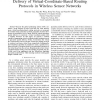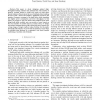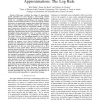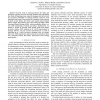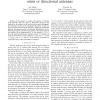INFOCOM
2009
IEEE
14 years 6 months ago
2009
IEEE
Abstract—Different geographic routing protocols have different requirements on routing metric designs to ensure proper operation. Combining a wrong type of routing metric with a ...
INFOCOM
2009
IEEE
14 years 6 months ago
2009
IEEE
Abstract—Because the global positioning system (GPS) consumes a large amount of power and does not work indoors, many virtual-coordinate-based routing protocols are proposed for ...
INFOCOM
2009
IEEE
14 years 6 months ago
2009
IEEE
Abstract—This paper is about designing optimal highthroughput hashing schemes that minimize the total number of memory accesses needed to build and access an hash table. Recent s...
INFOCOM
2009
IEEE
14 years 6 months ago
2009
IEEE
—In current multi-channel live P2P video systems, there are several fundamental performance problems including exceedingly-large channel switching delays, long playback lags, and...
INFOCOM
2009
IEEE
14 years 6 months ago
2009
IEEE
—This paper considers the design of opportunistic packet schedulers for users sharing a time-varying wireless channel from the performance and the robustness points of view. Firs...
INFOCOM
2009
IEEE
14 years 6 months ago
2009
IEEE
—The recently proposed Pocket Switched Network paradigm takes advantage of human social contacts to opportunistically create data paths over time. We examine how effective such a...
INFOCOM
2009
IEEE
14 years 6 months ago
2009
IEEE
—Current work in routing protocols for delay and disruption tolerant networks leverage epidemic-style algorithms that trade off injecting many copies of messages into the network...
INFOCOM
2009
IEEE
14 years 6 months ago
2009
IEEE
—In this paper we analyze the capacity of wireless mesh networks that use omni or directional antennas. The capacity in our analysis is the end-to-end per-node throughput. Our an...
INFOCOM
2009
IEEE
14 years 6 months ago
2009
IEEE
—In this paper, we study an online bipartite matching problem, motivated by applications in wireless communication, content delivery, and job scheduling. In our problem, we have ...
INFOCOM
2009
IEEE
14 years 6 months ago
2009
IEEE
Abstract— Although direct reciprocity (Tit-for-Tat) contribution systems have been successful in reducing freeloading in peerto-peer overlays, it has been shown that, unless the ...

